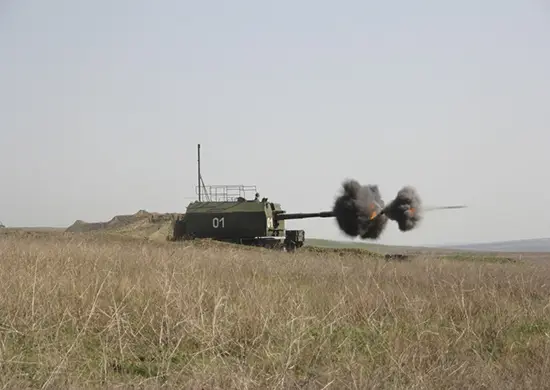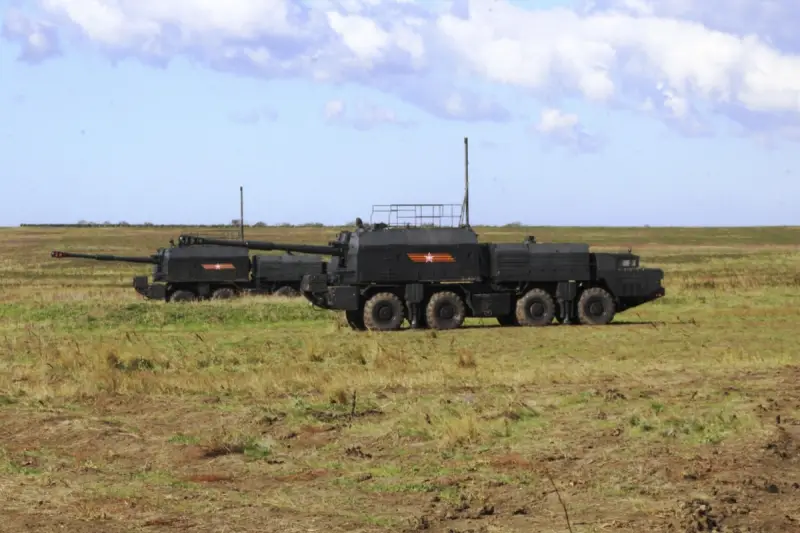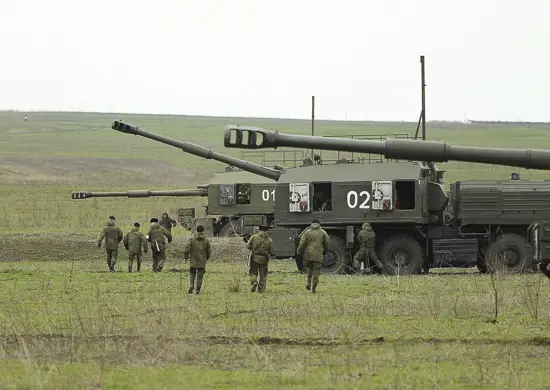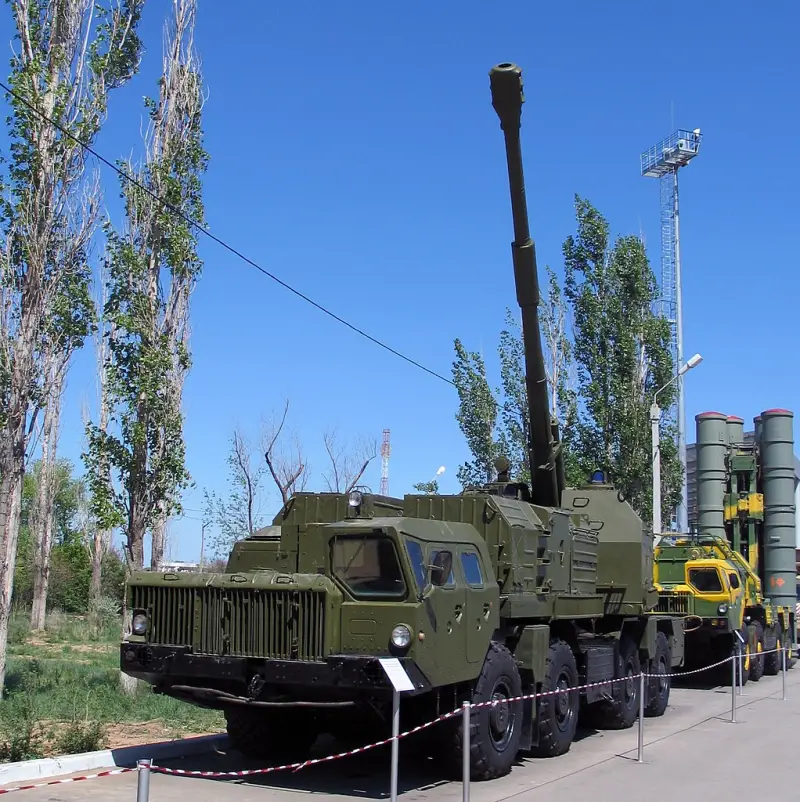"Bereg" complexes for the Dnieper river flotilla

Just a few days ago it became known about the formation of the Dnieper River flotilla, which will have to strengthen our grouping of troops in important sectors of the front. Now the first detailed information about the structure, capabilities and equipment of the new association is appearing. As expected, the flotilla will have its own coastal troops. In particular, it will be equipped with artillery units equipped with A-222 Bereg complexes.
According to new data
The formation of the Dnieper River Flotilla was officially announced by Defense Minister Sergei Shoigu on March 20. He said that a brigade of boats was included in this naval association, but other details remained unknown. Soon new information about the structure and capabilities of the flotilla appeared in the press.
On March 22, the Izvestia publication, citing its sources in the defense department, reported the formation of coastal units. The Dnieper flotilla will have its own marines and special forces. In addition, it will receive artillery units equipped with A-222 Bereg coastal artillery systems (BAK).
The number and composition of the flotilla's artillery batteries are not reported. Probably, Izvestia’s sources do not have such information or cannot disclose it. At the same time, the publication provides an assessment of specialized experts who point out the correctness of equipping coastal troops with artillery and the potential of such a solution.
It is expected that the Dnieper River Flotilla will begin full service and begin combat missions in the very near future. Accordingly, one can expect news about the start of combat work of artillerymen and about the destruction of enemy targets. It is obvious that the involvement of “Bereg” will improve the situation in the Dnieper direction and will make a certain contribution to achieving the general goals of the Special Operation.
Predictable step
It should be recalled that coastal units of various kinds exist within all operational-strategic formations of the Russian Navy, regardless of their size and location. Coastal forces of four navies and one flotilla include marines, tank units, artillery and missile systems, air defense, etc.

The existing coastal units are armed with artillery systems of various types of almost all major calibers. There are both 82-mm mortars 2B14 "Podnos" and 152-mm towed guns 2A36 "Gyacinth-B" and 2A65 "Msta-B". Self-propelled artillery is widely represented - from 120-mm systems of the Nona family to 152-mm self-propelled guns 2S19 Msta-S. A separate niche in this nomenclature is occupied by the A-222 “Bereg” tank, created to solve a specific range of tasks.
The current processes of creating a new Dnieper river flotilla are carried out in accordance with established standards and principles. As a result, this association, like others, should have coastal units, incl. artillery. For this reason, the latest news is not unexpected and does not raise questions.
At the same time, you can pay attention to the type of artillery system chosen. Of the variety of guns and self-propelled guns in service with the coastal troops, the BAK A-222 was chosen for the Dnieper flotilla. The reason for this choice could be a special combination of tactical and technical characteristics and combat qualities of the complex. At the same time, it cannot be ruled out that other models will also enter service with the flotilla.
One way or another, it is obvious that the Ministry of Defense is counting on the maximum result when forming a new flotilla and coastal troops. The troops as a whole will have to strengthen the grouping in the Dnieper direction, and the Bereg complexes will strengthen its overall firepower and provide some special capabilities.
It should be recalled that the coastal units of the Russian Navy have no more than 5-6 Bereg divisions. All this equipment was supplied to the coastal troops of the Black Sea Fleet in the past. The deployment of A-222 products in parts of other fleets was not considered unnecessary at that time. Now they decided that this type of equipment is necessary for the new Dnieper river flotilla. Apparently, the UAV for the flotilla will be taken from the coastal troops of the KChF.
Specialized sample
The coastal defense artillery system with the code “Bereg” has been developed since the late seventies at OKB-2 of the Barrikady plant (Volgograd). In the late eighties, the first experimental complex went into testing, and a few years later the product was put into service. Testing and preparation for serial production were carried out during a difficult period, which negatively affected the deadlines. The first serial complex was transferred to the Navy only in 2003.

The Bereg tank includes a central post, six self-propelled guns and one or two combat duty support vehicles, as well as various auxiliary equipment. Organizationally, all the assets of the complex are consolidated into an artillery division with three batteries of two self-propelled guns each. The division is an independent combat unit, capable of moving around the theater and responding to threats.
All BAC vehicles are built on the MAZ-543M wheeled chassis, which provides high mobility on roads and terrain. The CPU and MOBD are equipped with kung vans with the necessary equipment, and self-propelled guns on the same base carry a turret-type fighting compartment.
The central post "Bereg" has a radar and an optical-electronic station for illuminating the situation, detecting and tracking surface targets at ranges of 35 km. It also calculates data for firing and controls fire installations.
The self-propelled gun carries a rotating turret with a modified 130-mm gun from the AK-130 shipborne mount. The design of the fighting compartment allows horizontal aiming within 120° to the right and left of the neutral position and elevation angles from -5° to +50°. The 130 mm rifled gun uses unitary shots with projectiles for various purposes. The main one is the F-44 high-explosive ammunition weighing 33,4 kg. Ammunition includes 40 rounds; manual loading with mechanical rammer. Rate of fire – up to 10 rds/min. Maximum range – 20-23 km.
TANK A-222 "Bereg" is capable of firing at stationary and moving surface or ground objects. If target tracking is possible, amendments are constantly made and fire is adjusted. Due to this, a high probability of hitting a small or medium-sized target such as a boat or ship is achieved. At the same time, a 130-mm high-explosive projectile is powerful enough to destroy or damage standard targets.
Future Challenges
The main task of the BAK A-222 is to provide anti-landing defense of the coast. In a dangerous situation, the complex must enter a given area and meet enemy ships and landing craft with heavy fire. One or two hits on a surface target will force its crew to stop performing their combat mission and move on to fighting for survivability, if it is possible after the damage received.

In addition, the Bereg can be used to inflict fire on landing enemy forces. In this case, it should work like “regular” ground self-propelled guns - fire across areas and destroy manpower or equipment.
It is easy to see that as part of the coastal troops of the Dnieper River Flotilla, the BAK A-222 will be able to use both of its functions and show good results. So, since last year, the enemy has been regularly making attempts to cross the Dnieper and land on our bank. Such attempts are suppressed by various means, incl. artillery using guided projectiles.
"Bereg" differs from other self-propelled guns in its special fire control system, optimized for work against surface targets. Such an artillery system will be able to independently search for and hit boats and boats, without the involvement of third-party reconnaissance and target designation, as well as using standard unguided ammunition. At the same time, the specifics of the tasks being solved and the characteristics of the expected targets level out the gap from ground self-propelled guns in caliber and firing range.
If necessary, the A-222 will be able to fire at targets on the opposite bank of the Dnieper. In this case, the BAC will complement other artillery and help solve common problems. However, the need to involve a specialized complex in such combat work is questionable. Towed guns and self-propelled guns of the ground forces, as well as front-line aviation and this is how they cope with the destruction of objects deep in enemy formations.
On a responsible direction
Thus, in accordance with the observed changes in the situation and existing strategic plans, the Russian armed forces are forming a new naval association in a responsible direction. The newly created Dnieper river flotilla will not differ in size, but should receive all the necessary forces and means, including coastal artillery.
It is now known that the flotilla’s artillery units will include a number of A-222 Bereg coastal systems with special functions and capabilities. They will allow our troops to more effectively fight the enemy on the Dnieper and beyond. In the near future, our armed forces can use this potential and show the desired results.
Information